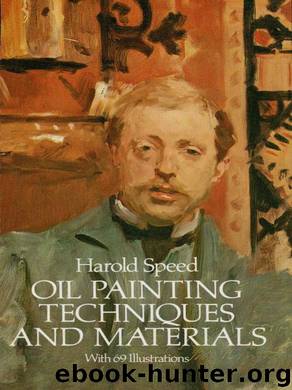Oil Painting Techniques and Materials by Harold Speed

Author:Harold Speed
Language: eng
Format: epub
ISBN: 9780486132693
Publisher: Dover Publications
Published: 2012-07-18T04:00:00+00:00
PLATE 28
PLATE 29
Do not neglect the under eyelid, as is so often done. I know of no part of a head that so easily shows the hand of the master as the painting of the under eyelid. And it is this that makes me think the fine portrait of Philip in the Dulwich Gallery, is not the original of Velasquez, but a copy. The under eyelids are so poorly constructed that to my thinking they show the hand of Manzo, or some other of Velasquez’s followers. However loosely Velasquez painted, the construction was always well understood.
In painting under eyelids see that they tuck in at the outer corner of the eye, following the spherical surface of the eyeball that disappears at this point. Note the soft line of the under edge of the band of tone marking the under eyelid, that goes from the outer to the inner corner of the eye. This is where the surface of the eyeball (on which the eyelid is placed) meets the surface of the cheek, and a sharp change of direction occurs. There is often a lot of loose flesh here which obscures the clearness of this transition. But be on the look out for any suggestion of this important structural feature.
Some more work was now done to the nose. In painting noses do not be in a hurry to put in the details of the nostrils ; and beware of making too much of the light that often runs from the cheek into the side of the nose. These smaller forms monopolise the attention, and obscure the bigger structural facts of modelling that should be put in first, and to which the others should be subordinate. The big structural fact of the nose is that it is made up of two planes converging at the top and wider apart at the base, rising from the plane of the cheeks and united by the ridge of the nose. This ridge is cut off at the tip of the nose by a little plane that usually shows a crisp high light, at their point of juncture. The plane of the side of the nose is generally marked by a change of tone from that of the cheek. And if you look at the subject with your eyes half closed, you will usually find a much more marked line from the wing of the nostril to the corner of the eye where these two planes meet, than is visible with them open. The odd thing about half closing your eyes to study your subject is, that while most of the smaller modelling disappears, the larger modelling stands more clearly defined in this muted vision of the subject. All the beginners I have seen make too much of the surface plane that runs from the cheek up the side of the nose, between the nostril and the corner of the eye. So be on the look out, not to let this unduly obscure the larger fact of the plane of the side of the nose meeting the plane of the cheek.
Download
This site does not store any files on its server. We only index and link to content provided by other sites. Please contact the content providers to delete copyright contents if any and email us, we'll remove relevant links or contents immediately.
The Husband's Secret by Liane Moriarty(2436)
Learn Drawing Quickly by Sharon Finmark(2417)
Drawing and Painting Birds by Tim Wootton(2338)
The Unlikely Pilgrimage of Harold Fry by Rachel Joyce(2137)
Classical Drawing Atelier by Juliette Aristides(1996)
One Drawing A Day by Veronica Lawlor(1720)
The Art of Creative Watercolor by Danielle Donaldson(1712)
Oil Painting For Dummies by Anita Marie Giddings & Sherry Stone Clifton(1658)
Hieronymus Bosch by Virginia Pitts Rembert(1577)
Elizabeth Is Missing by Emma Healey(1565)
Anywhere, Anytime Art: Crayon by Monika Forsberg(1521)
Special Subjects: Basic Color Theory by Patti Mollica(1514)
Post-Impressionism by Nathalia Brodskaya(1511)
Woman's Mysteries by Esther Harding(1460)
Memory's Wake by Fenech Selina(1399)
Fundamentals of Drawing by Barrington Barber(1260)
Landscape Painting in Pastel by Elizabeth Mowry(1210)
Acrylic Fusion by Dan Tranberg(1209)
Drawing by William Powell(1196)
